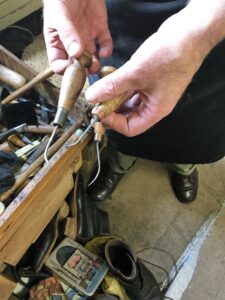Gressenhall was one of a few workhouses that provided these shoes to the paupers in their care instead of giving them an allowance and letting them fend for themselves. Despite coming from the late 1700’s or early 1800’s, these shoes resemble modern day work shoes quite a bit. They appear to be made of brown leather with slightly raised heels (the newer shoes have heels made of rubber, but the older shoes’ heels may be made of wood). The laces are made out of leather as well. The material of the shoes, even to this day, is considered both durable and waterproof, although it’s unclear exactly how waterproof these older shoes are (current leather boots are treated with chemicals to be more water resistant).
The children’s shoes of Gressenhall are much more plain in color and decoration than the shoes of their peers. They also are of a different material: some shoes would be made of linen, cotton or even silk. Another thing to note is that the heel of the boots is rather low. This is another signifier of class; the richer the person, the higher the shoe’s heel. The fact that this idea was passed down to even the youngest of English people shows the extreme class stratification for English society at the time.
Men’s Boots & Shoes | Official Dr Martens Store. http://www.drmartens.com/us/c/mens.
“Girl’s Tie Shoe.” Girl’s Tie Shoe – MAAS. https://collection.maas.museum/object/239340.
“Pair of Silk Satin Buckle Shoes Wiith Buckles.” Pair of Silk Satin Buckle Shoes Wiith Buckles – MAAS. https://collection.maas.museum/object/239900.
Styles, John. The Dress of the People: Everyday Fashion in Eighteenth-century England. Yale University Press, 2013.
“Cobbler_replica_child.JPG.” Google Drive. https://drive.google.com/file/d/1ebOhl4TLRr_GIywjQ3z9qBzA_Zu6yrWC/view.



